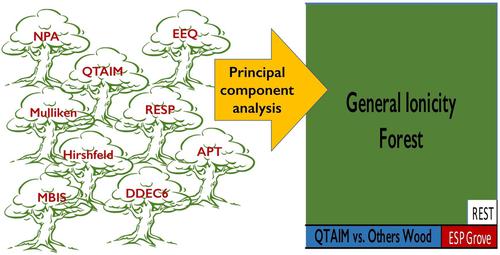当前位置:
X-MOL 学术
›
ChemPhysChem
›
论文详情
Our official English website, www.x-mol.net, welcomes your feedback! (Note: you will need to create a separate account there.)
The Atomic Partial Charges Arboretum: Trying to See the Forest for the Trees.
ChemPhysChem ( IF 2.9 ) Pub Date : 2020-03-23 , DOI: 10.1002/cphc.202000040 Minsik Cho 1, 2 , Nitai Sylvetsky 1 , Sarah Eshafi 1, 3 , Golokesh Santra 1 , Irena Efremenko 1 , Jan M L Martin 1
ChemPhysChem ( IF 2.9 ) Pub Date : 2020-03-23 , DOI: 10.1002/cphc.202000040 Minsik Cho 1, 2 , Nitai Sylvetsky 1 , Sarah Eshafi 1, 3 , Golokesh Santra 1 , Irena Efremenko 1 , Jan M L Martin 1
Affiliation

|
Atomic partial charges are among the most commonly used interpretive tools in quantum chemistry. Dozens of different ‘population analyses’ are in use, which are best seen as proxies (indirect gauges) rather than measurements of a ‘general ionicity’. For the GMTKN55 benchmark of nearly 2,500 main‐group molecules, which span a broad swathe of chemical space, some two dozen different charge distributions were evaluated at the PBE0 level near the 1‐particle basis set limit. The correlation matrix between the different charge distributions exhibits a block structure; blocking is, broadly speaking, by charge distribution class. A principal component analysis on the entire dataset suggests that nearly all variation can be accounted for by just two ‘principal components of ionicity’: one has all the distributions going in sync, while the second corresponds mainly to Bader QTAIM vs. all others. A weaker third component corresponds to electrostatic charge models in opposition to the orbital‐based ones. The single charge distributions that have the greatest statistical similarity to the first principal component are iterated Hirshfeld (Hirshfeld‐I) and a minimal‐basis projected modification of Bickelhaupt charges. If three individual variables, rather than three principal components, are to be identified that contain most of the information in the whole dataset, one representative for each of the three classes of Corminboeuf et al. is needed: one based on partitioning of the density (such as QTAIM), a second based on orbital partitioning (such as NPA), and a third based on the molecular electrostatic potential (such as HLY or CHELPG).
中文翻译:

原子部分电荷植物园:试图从森林看树木。
原子部分电荷是量子化学中最常用的解释工具。正在使用数十种不同的“人口分析”,最好将其视为代理(间接量表),而不是对“一般离子性”进行测量。对于跨越大范围化学空间的近2,500个主族分子的GMTKN55基准,在接近1粒子基础集极限的PBE0水平上评估了大约两打不同的电荷分布。不同电荷分布之间的相关矩阵呈现出块状结构。从广义上讲,阻塞是按电荷分配类别进行的。对整个数据集的主成分分析表明,几乎所有的变化都可以由两个“离子性的主要成分”来解释:一个具有所有分布同步,而第二个主要对应于Bader QTAIM与其他所有内容。与基于轨道的模型相反,较弱的第三部分对应于静电荷模型。与第一个主成分在统计上具有最大相似性的单电荷分布是迭代Hirshfeld(Hirshfeld-I)和Bickelhaupt电荷的最小基数预计修正。如果要确定包含整个数据集中大多数信息的三个独立变量,而不是三个主要成分,则Corminboeuf等人的三类中的每一个都有一个代表。需要:一种基于密度分配(例如QTAIM),第二种基于轨道分配(例如NPA),第三种基于分子静电势(例如HLY或CHELPG)。与基于轨道的模型相反,较弱的第三部分对应于静电荷模型。在统计上与第一个主成分具有最大相似性的单个电荷分布是迭代Hirshfeld(Hirshfeld-I)和Bickelhaupt电荷的最小基数预计修正。如果要确定包含整个数据集中大多数信息的三个独立变量,而不是三个主要成分,则Corminboeuf等人的三类中的每一个都有一个代表。需要:一种基于密度分配(例如QTAIM),第二种基于轨道分配(例如NPA),第三种基于分子静电势(例如HLY或CHELPG)。与基于轨道的模型相反,较弱的第三部分对应于静电荷模型。在统计上与第一个主成分具有最大相似性的单个电荷分布是迭代Hirshfeld(Hirshfeld-I)和Bickelhaupt电荷的最小基数预计修正。如果要确定包含整个数据集中大多数信息的三个独立变量,而不是三个主要成分,则Corminboeuf等人的三类中的每一个都有一个代表。需要:一种基于密度分配(例如QTAIM),第二种基于轨道分配(例如NPA),第三种基于分子静电势(例如HLY或CHELPG)。在统计上与第一个主成分具有最大相似性的单个电荷分布是迭代Hirshfeld(Hirshfeld-I)和Bickelhaupt电荷的最小基数预计修正。如果要确定包含整个数据集中大多数信息的三个独立变量,而不是三个主要成分,则Corminboeuf等人的三类中的每一个都有一个代表。需要:一种基于密度分配(例如QTAIM),第二种基于轨道分配(例如NPA),第三种基于分子静电势(例如HLY或CHELPG)。与第一个主成分在统计上具有最大相似性的单电荷分布是迭代Hirshfeld(Hirshfeld-I)和Bickelhaupt电荷的最小基数预计修正。如果要确定包含整个数据集中大多数信息的三个独立变量,而不是三个主要成分,则Corminboeuf等人的三类中的每一个都有一个代表。需要:一种基于密度分配(例如QTAIM),第二种基于轨道分配(例如NPA),第三种基于分子静电势(例如HLY或CHELPG)。如果要确定包含整个数据集中大多数信息的三个独立变量,而不是三个主要成分,则Corminboeuf等人的三类中的每一个都有一个代表。需要:一种基于密度分配(例如QTAIM),第二种基于轨道分配(例如NPA),第三种基于分子静电势(例如HLY或CHELPG)。如果要确定包含整个数据集中大多数信息的三个独立变量,而不是三个主要成分,则Corminboeuf等人的三类中的每一个都有一个代表。需要:一种基于密度分配(例如QTAIM),第二种基于轨道分配(例如NPA),第三种基于分子静电势(例如HLY或CHELPG)。
更新日期:2020-03-23
中文翻译:

原子部分电荷植物园:试图从森林看树木。
原子部分电荷是量子化学中最常用的解释工具。正在使用数十种不同的“人口分析”,最好将其视为代理(间接量表),而不是对“一般离子性”进行测量。对于跨越大范围化学空间的近2,500个主族分子的GMTKN55基准,在接近1粒子基础集极限的PBE0水平上评估了大约两打不同的电荷分布。不同电荷分布之间的相关矩阵呈现出块状结构。从广义上讲,阻塞是按电荷分配类别进行的。对整个数据集的主成分分析表明,几乎所有的变化都可以由两个“离子性的主要成分”来解释:一个具有所有分布同步,而第二个主要对应于Bader QTAIM与其他所有内容。与基于轨道的模型相反,较弱的第三部分对应于静电荷模型。与第一个主成分在统计上具有最大相似性的单电荷分布是迭代Hirshfeld(Hirshfeld-I)和Bickelhaupt电荷的最小基数预计修正。如果要确定包含整个数据集中大多数信息的三个独立变量,而不是三个主要成分,则Corminboeuf等人的三类中的每一个都有一个代表。需要:一种基于密度分配(例如QTAIM),第二种基于轨道分配(例如NPA),第三种基于分子静电势(例如HLY或CHELPG)。与基于轨道的模型相反,较弱的第三部分对应于静电荷模型。在统计上与第一个主成分具有最大相似性的单个电荷分布是迭代Hirshfeld(Hirshfeld-I)和Bickelhaupt电荷的最小基数预计修正。如果要确定包含整个数据集中大多数信息的三个独立变量,而不是三个主要成分,则Corminboeuf等人的三类中的每一个都有一个代表。需要:一种基于密度分配(例如QTAIM),第二种基于轨道分配(例如NPA),第三种基于分子静电势(例如HLY或CHELPG)。与基于轨道的模型相反,较弱的第三部分对应于静电荷模型。在统计上与第一个主成分具有最大相似性的单个电荷分布是迭代Hirshfeld(Hirshfeld-I)和Bickelhaupt电荷的最小基数预计修正。如果要确定包含整个数据集中大多数信息的三个独立变量,而不是三个主要成分,则Corminboeuf等人的三类中的每一个都有一个代表。需要:一种基于密度分配(例如QTAIM),第二种基于轨道分配(例如NPA),第三种基于分子静电势(例如HLY或CHELPG)。在统计上与第一个主成分具有最大相似性的单个电荷分布是迭代Hirshfeld(Hirshfeld-I)和Bickelhaupt电荷的最小基数预计修正。如果要确定包含整个数据集中大多数信息的三个独立变量,而不是三个主要成分,则Corminboeuf等人的三类中的每一个都有一个代表。需要:一种基于密度分配(例如QTAIM),第二种基于轨道分配(例如NPA),第三种基于分子静电势(例如HLY或CHELPG)。与第一个主成分在统计上具有最大相似性的单电荷分布是迭代Hirshfeld(Hirshfeld-I)和Bickelhaupt电荷的最小基数预计修正。如果要确定包含整个数据集中大多数信息的三个独立变量,而不是三个主要成分,则Corminboeuf等人的三类中的每一个都有一个代表。需要:一种基于密度分配(例如QTAIM),第二种基于轨道分配(例如NPA),第三种基于分子静电势(例如HLY或CHELPG)。如果要确定包含整个数据集中大多数信息的三个独立变量,而不是三个主要成分,则Corminboeuf等人的三类中的每一个都有一个代表。需要:一种基于密度分配(例如QTAIM),第二种基于轨道分配(例如NPA),第三种基于分子静电势(例如HLY或CHELPG)。如果要确定包含整个数据集中大多数信息的三个独立变量,而不是三个主要成分,则Corminboeuf等人的三类中的每一个都有一个代表。需要:一种基于密度分配(例如QTAIM),第二种基于轨道分配(例如NPA),第三种基于分子静电势(例如HLY或CHELPG)。


























 京公网安备 11010802027423号
京公网安备 11010802027423号